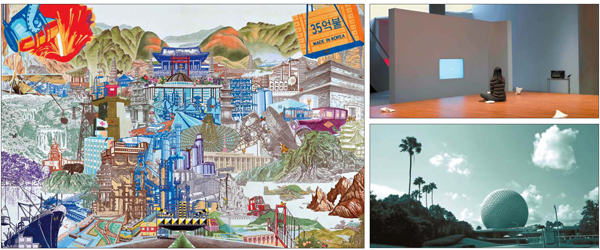Imagining Korean society’s past and future

Artist An Dong-il’s painting “Our Land of Korea,” above; artist group Okin Collective’s installation work “Art Spectral,” top right; and artist Park Min-ha’s video “Remixing Timespace,” bottom right, are part of “ArtSpectrum 2016,” a collective exhibition of the 10 finalists for the museum’s biennial ArtSpectrum Award. It starts today at the Leeum, Samsung Museum of Art, in central Seoul. [LEEUM, SAMSUNG MUSEUM OF ART]
Still, many of the artworks on display - diverse in concept and medium - have something in common. That is an interest in Korean society’s past as traces, collective memories or selective records, and in its future as the expectations and concerns of the present.
Artist An Dong-il presents a large-scale landscape painting in which mountains, islands, Korea’s famous cultural heritage sites, industrial complexes and expressways are tangled.
In fact, it is a composite of the iconic images from stamps issued during the Park Chung Hee administration in the 1960s and ’70s. The images were selected for the administration’s two important goals: economic development through industrialization and the instillation of national pride.
Accordingly, the composite of these images, titled “Our Land of Korea” makes a utopian landscape under the ideology of Korea’s history of rapid industrialization, which still influences the present.
“The 33-year-old artist has been interested in the time in which his now-deceased father spent his youth,” said Gina Lee, curator of the exhibition.
Artist and film director Kelvin Kyung Kun Park’s new short film “Army: 600,000 Portraits” is related to Korean society at present. It makes a collective portrait of young Korean men during their mandatory military service through capturing fragments of military living and culture.
Nearly every Korean man would find it familiar, but the images captured by Park, who experienced culture shock during military service after growing up abroad, have an unfamiliar atmosphere.
The highlight is the scene in which numerous young soldiers, seen from a high vantage point, are exhilarated and fascinated by a Christian community music performance by young women in the style of a typical girl group during a Christian event.
And leading visitors to think about present and future economic conditions, the graphic design and data visualization duo Optical Race will present an installation of infographics titled “Make a Family as You Wish.” In the space, viewers are invited to see how their economic conditions after marriage will be according to their current income, their parents’ assets and their future spouses’ income.
“The work shows the reality of the flagging Korean economy through the marriage simulation of so-called echo boomers [children of baby boomers born between 1979 and 1992], who self-deprecatingly call themselves the generation that gives up three things [dating, marriage and children],” curator Lee said.
The other finalists are Kim Young-eun, Park Min-ha, Choi Hae-ri, Baek Jung-ki, Lee Ho-in, Jane Jin Kaisen and the Okin Collective, which is a team of three artists. One of the finalists will be selected as winner and receive 30 million won ($25,600) in prize money.
BY MOON SO-YOUNG [symoon@joongang.co.kr]
The exhibition runs through Aug. 7. Admission is 5,000 won for adults. The museum is closed on Mondays. Go to Hangangjin Station, line No. 6, exit 1, and walk for five minutes.
For details, visit www.leeum.org or call (02) 2014-6901.










with the Korea JoongAng Daily
To write comments, please log in to one of the accounts.
Standards Board Policy (0/250자)